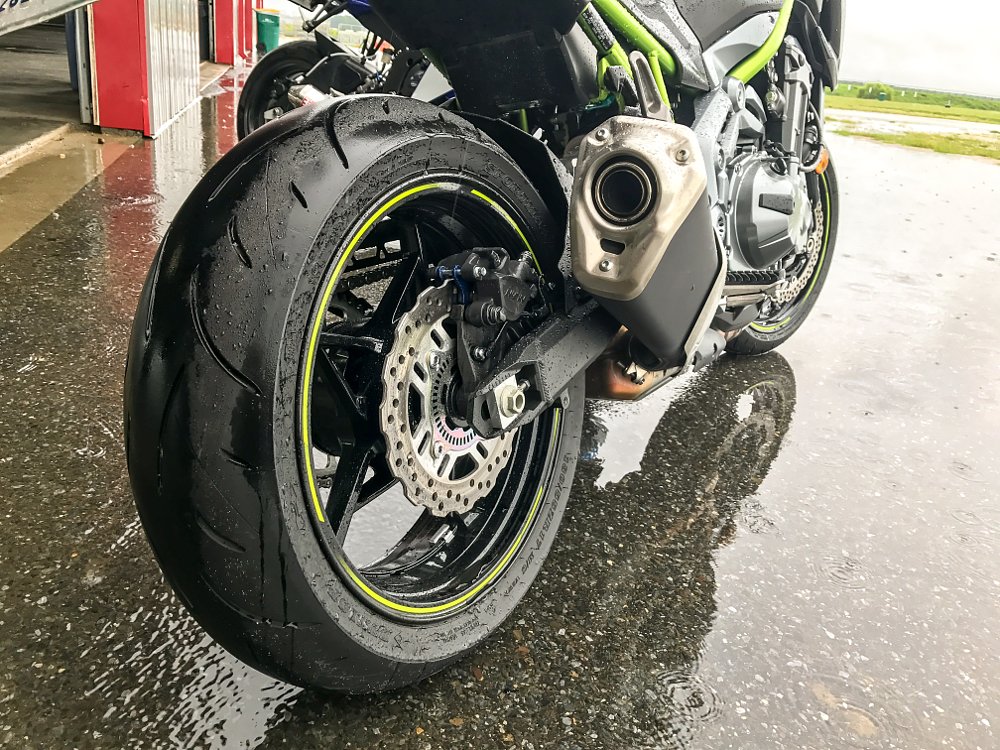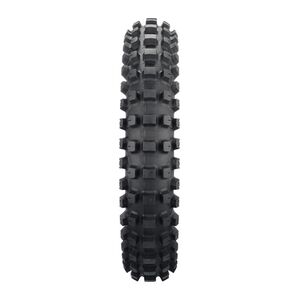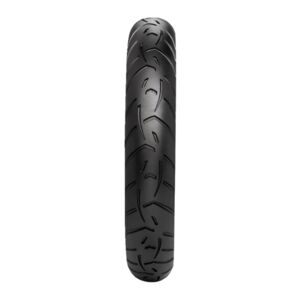Some of the most common questions we deal with at Common Tread revolve around tires, and for good reason. No matter how much technology you have on your motorcycle, at the end of the day it’s still the rubber that meets the road. Without the appropriate set of skins, your motorcycle won’t perform the way you expect.
Pulling from a lifetime of experiences between Lance, Lem, and myself, I want to dive into a look at the one item on a motorcycle that is so often overlooked. Whether you are just starting out or getting into a new type of riding, there are a lot of options to consider when outfitting your bike with new rubber. While Lem has already broken down the basics for you in his Tires 101 guide, these are a few extra pointers that address tire traction.
Tires are purpose-built items. Understanding what the engineers had in mind when they designed the tires will help you choose the best solution for your kind of riding. A knobby tire designed to provide traction in the dirt will provide minimal grip on the street. A track day tire meant to provide maximum grip on a sport bike will provide disappointing mileage if you use it to commute to the office, and you may never get it hot enough to extract maximum traction from it, anyway.
The good news is that there are tires out there for virtually every type of riding, and they’re better than they’ve ever been before. It only becomes a problem when riders try to tackle different types of riding with one bike. But even then, there are some great tires that strike a solid compromise across genres.

On the asphalt
Last summer, Lance and I did a track day during what could only be described as a monsoon. He was on a 2014 Yamaha YZF-R6 with Pirelli Diablo Rosso III tires while I was on our long-term 2017 Kawasaki Z900 with the factory Dunlop Sportmax D214 tires. Even with the advantage of ABS and a slipper clutch, the Z900 couldn’t maintain traction well enough to keep up with the R6. Lance, having a hard time believing the tires could be that bad, swapped bikes with me. He lasted half a session before he’d had enough of sliding around and pulled into the pits.
When I originally tested the Z900 in California, I found the stock tires to work just fine. They turned in rather predictably and I never felt that the grip was compromised, even when the pace picked up. But the story was totally different in the rain.
One of the biggest innovations we’ve seen in the world of street tires is the introduction of silica in the compound of the rubber. Prior to this, engineers' main tool in expelling water and maintaining traction was limited to utilizing varying tread patterns. In perfect conditions, riding on ideal surfaces, there would be no need for tread patterns, as they reduce the amount of rubber within the contact patch that mates up with the surface of the road. This is why race tires are slicks.

In the real world, however, conditions are less than ideal. In addition to giving folks a visual marker for determining when a tire is ready for replacement, tread patterns also introduce flex, which allows the tire to better mate with with uneven road surfaces. But their main feature, as I previously mentioned, is to expel water, thus allowing the tire to maintain grip in wet weather. By introducing silica to the compound of the rubber, engineers are able to provide increased wet-weather traction with minimal patterns cut into the tread. The result is better traction in wet conditions.
Early in my career at RevZilla, a representative from Metzeler referred to the process of altering the rubber compound of a tire as improving its "chemical grip," and that term has always stuck with me. Silica allows engineers to utilize harder compounds to minimize rolling resistance and thus improve fuel economy and tire longevity with minimal sacrifice to the traction the tires provide. The result is a street tire that works for a wider range of applications while simultaneously providing longer life.
Traditionally speaking, you could think of grip and longevity as a seesaw (I am stealing Lemmy's analogy here). A tire that offers more grip usually does so at the expense of longevity, and a tire designed to offer high mileage results will sacrifice a certain level of grip. There are a lot of other factors to consider, such as a tire's load and speed rating, how much your bike weighs, whether or not you're carrying a passenger or luggage, or how aggressive you are with the throttle, but thinking of that seesaw is a good place to start.
With that in mind, it’s still important to choose the right tire for your intended style of riding. If tire longevity is a priority for commuting and street sport riding, you should look at something like a Michelin Road 5 or a Bridgestone Battlax T31. These tires might be a bit pricier than others, but they provide high levels of traction in all weather conditions while also delivering on the promise of longevity. If your primary focus is aggressive riding on the track, with the occasional rip on the street, I’d recommend looking at the Pirelli Diablo Supercorsa SP V2 or the Dunlop Q3 Plus Sportmax tires. I've used both of these tires on the street as well as the racetrack, and they provide tremendous amounts of dry weather grip but aren't as good in the rain and tend to wear out relatively quickly.
Returning from the track day like a pair of wet dogs, Lance and I briefed Lemmy on the Z900’s performance in the rain. Never one to take someone else’s word for it, he rode the Z900 home in a thunderstorm. He called me later that night to tell me all about his perilous journey and how he agreed with my assessment of the tires. Our conversation was cut short when Mrs. Lemmy was suddenly heard in the background demanding to know who had left muddy boot tracks through her kitchen.

Traction off-road
A few weeks ago, I was playing hooky from work. After a brutally cold east coast winter, I wasn’t about to spend the first day of sunshine and 60-degree temperatures sitting at a desk. Instead, I was up at dawn, loading up my KTM 1090 Adventure R and my friend Liz’s KTM 250 EXC-F into the back of my truck for a day of off-road exploration in the Pine Barrens.
In an effort to squeeze maximum life out of the rear Continental Twinduro TKC80 tire on my KTM 1090 Adventure R (in other words, I was too lazy to replace it the night before), I set off with a "fairly worn" rear tire. I knew better, yet I convinced myself I could lower the air pressure to gain back enough traction for one last ride. And that is the beginning of a story about how I spent a good portion of the day digging my 1090 out of a giant mud pit.
Finding traction in off-road situations can be a daunting task. Dirt bike and enduro tires have different tread patterns specific to different types of terrain. As most of those machines will never see tarmac, tire manufacturers are not beholden to DOT standards. With larger adventure bikes, however, nearly all of the tires designed for standard fitment will have at least some street bias.
Unlike street tires, which utilize chemical grip to increase traction, the primary grip for off-road tires still comes through tread patterns, or mechanical grip. The bike’s size and weight also come into play. Let’s consider for a moment the Continental TKC 80 tires that come stock on the KTM.

On adventure bikes, they work relatively well, so they’ve become a go-to workhorse tire for the adventure crowd. They provide a decent amount of traction for folks looking to try their hand at riding off-road while maintaining relatively predictable street manners. The most common complaint is their longevity. If you achieve 3,000 miles out of a rear, consider yourself lucky. If you’re using it off-road, however, rear-wheel traction begins to fade around half of that.
That is because unlike street tires, which rely on the tread to create a contact patch with the asphalt, in off-road use the tire relies on the tread, or "knobbies," to dig into the dirt to provide grip. As the tires wear, the surface area of the knobs remains the same but their height decreases, so they are constantly providing less traction as they wear.

On KTM’s smaller, lighter line of EXC dual-sport bikes, the TKC 80 proves to be an impractical choice for a bike that’s really intended to live off-road. Liz had ditched the Continentals, which were stock on her bike, in favor of a set of Kenda K-760 Trakmaster II tires, a very aggressive DOT dual-sport tire. If you’re not worried about the DOT rating, the Dunlop AT81 Enduro tires are a super popular do-anything enduro option.
As with street rubber, tire selection is a compromise that requires a hard look at the type of riding you’re intending to tackle. If your adventure bike spends the majority of its time in the dirt, a Mitas E-09 or a Goldentyre GT723 will serve your needs better than a TKC80.

When I was testing the 1090 Adventure R, I had the opportunity to run it in stock form against my Triumph Tiger 800 XCx, which was wearing Mitas E-09s. Getting to try the tires side by side off-road was a night-and-day experience. The E-09s maintained traction better off-road when directly compared to the TKC80s. However, on the pavement the E-09s inspired no confidence whatsoever.

Those of you who spend more time on the street and tackle nothing more than some regular fire roads will probably be happier with something like the Heidenau K60 Scout or the Mitas E-07. You’ll get more than double the life out of the rear than a TKC80 or an E-09, it’ll handle better on the street, and you’ll still be able to do some lightweight off-road riding.
Finally, for those of you using an adventure bike as a large, fast, comfortable, touring motorcycle, my main advice is to stick with street-focused rubber. Trying to use a knobbier tire to achieve a certain look is only going to reduce the performance of your machine. Try a set of Metzeler Tourance NEXT tires or Pirelli Scorpion Trail II skins.
Conclusion: If your tires don’t work, nothing else will
Tires aren’t sexy, but in many cases there is nothing you can do that will improve your enjoyment of riding your bike more than a new set of really good tires. With that in mind, don’t assume that the tires on your brand new bike are the best choice. Often times, a manufacturer looks at tires as an area for cost-cutting. You would think that tire manufacturers would intervene in an effort to get their best options in front of customers, but that doesn’t seem to be the case.
Using our Z900 as an example, the stock Dunlop Sportmax D214 were lousy in the rain. Unfortunately, that leads a lot of consumers to assume that all Dunlop tires are lousy, which is certainly not the case. We swapped the stock tires for a set of Dunlop Roadsmart III tires and they have worked great for regular street use.

Whether you’re riding on the street, the track, or the dirt, getting the right set of tires can make a huge difference. A day spent digging a large adventure bike out of a mud puddle is still more fun than a day spent behind a desk, but it’s not the same as getting to rip around all day with a set of tires hooking up. The most powerful street bike is hamstrung if it can’t get that power to the ground and the most sophisticated electronic aids in the world won’t give you confidence and control if your tires can’t provide the needed traction.
Choose wisely.




























